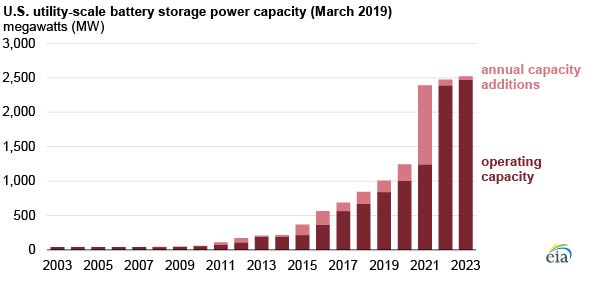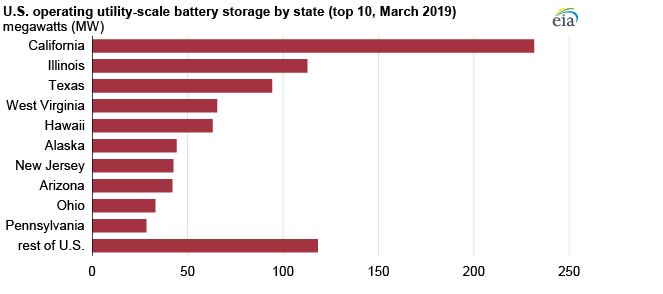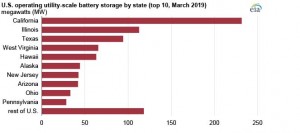
Utility-scale battery storage units (units of one megawatt (MW) or greater power capacity) are a newer electric power resource, and their use has been growing in recent years. Operating utility-scale battery storage power capacity has more than quadrupled from the end of 2014 (214 MW) through March 2019 (899 MW). Assuming currently planned additions are completed and no current operating capacity is retired, utility-scale battery storage power capacity could exceed 2,500 MW by 2023.
EIA's Annual Electric Generator Report (Form EIA-860) collects data on the status of existing utility-scale battery storage units in the United States, along with proposed utility-scale battery storage projects scheduled for initial commercial operation within the next five years. The monthly version of this survey, the Preliminary Monthly Electric Generator Inventory (Form EIA-860M), collects the updated status of any projects scheduled to come online within the next 12 months.
Growth in utility-scale battery installations is the result of supportive state-level energy storage policies and the Federal Energy Regulatory Commission’s Order 841 that directs power system operators to allow utility-scale battery systems to engage in their wholesale energy, capacity, and ancillary services markets. In addition, pairing utility-scale battery storage with intermittent renewable resources, such as wind and solar, has become increasingly competitive compared with traditional generation options.
The two largest operating utility-scale battery storage sites in the United States as of March 2019 provide 40 MW of power capacity each: the Golden Valley Electric Association’s battery energy storage system in Alaska and the Vista Energy storage system in California. In the United States, 16 operating battery storage sites have an installed power capacity of 20 MW or greater. Of the 899 MW of installed operating battery storage reported by states as of March 2019, California, Illinois, and Texas account for a little less than half of that storage capacity.

In the first quarter of 2019, 60 MW of utility-scale battery storage power capacity came online, and an additional 108 MW of installed capacity will likely become operational by the end of the year. Of these planned 2019 installations, the largest is the Top Gun Energy Storage facility in California with 30 MW of installed capacity.
As of March 2019, the total utility-scale battery storage power capacity planned to come online through 2023 is 1,623 MW. If these planned facilities come online as scheduled, total U.S. utility-scale battery storage power capacity would nearly triple by the end of 2023. Additional capacity beyond what has already been reported may also be added as future operational dates approach.
Of all planned battery storage projects reported on Form EIA-860M, the largest two sites account for 725 MW and are planned to start commercial operation in 2021. The largest of these planned sites is the Manatee Solar Energy Center in Parrish, Florida. With a capacity of 409 MW, this project will be the largest solar-powered battery system in the world and will store energy from a nearby Florida Power and Light solar plant in Manatee County.
The second-largest planned utility-scale battery storage facility is the Helix Ravenswood facility located in Queens, New York. The site is planned to be developed in three stages and will have a total capacity of 316 MW.


Follow us on social media: